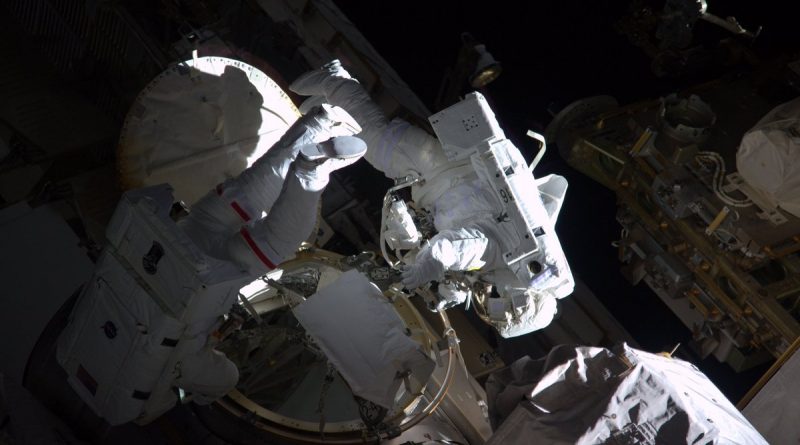Busy Spacewalk outside ISS Highlights NASA’s Problem Solving Skills
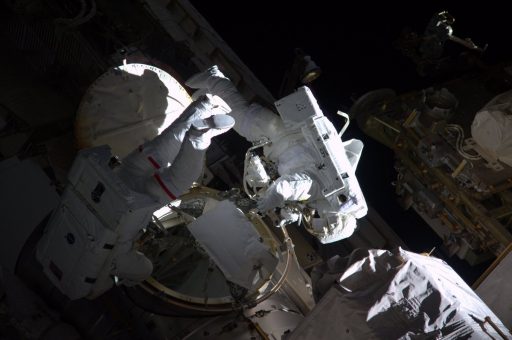
Two veteran spacewalkers worked overtime outside the International Space Station on Thursday to outfit a recently relocated docking module, upgrade the Station’s external computer system and put in place a series of protective covers to shield a docking port against harmful debris impacts.
Expedition 50 commander Shane Kimbrough and Flight Engineer Peggy Whitson worked outside for seven hours and four minutes and accomplished all of the EVA’s objectives thanks to ingenuity of teams on the ground who came up with a makeshift plan to replace a protective cover that had inadvertently floated away after becoming untethered from the crew. Thursday’s EVA marked the second of two excursions needed to outfit Pressurized Mating Adapter 3 to be ready for its conversion to a Commercial Crew docking port with the installation of a docking adapter that will launch late this year or early in 2018.
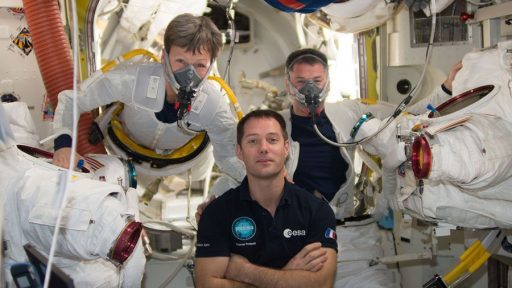
Embarking on her eighth spacewalk, veteran Astronaut Peggy Whitson set a pair of records, becoming the female Astronaut with the most career EVAs and also surpassing NASA’s Suni Williams for cumulative EVA time, now with over 50 hours of spacewalking time under her belt. For the Space Station overall, Thursday’s excursion marked the 199th EVA dedicated to ISS Assembly and Maintenance.
Thursday’s EVA was preceded by a spacewalk last week by Shane Kimbrough and ESA Astronaut Thomas Pesquet during which four connectors were removed from Pressurized Mating Adapter 3 to free it up for removal from the Node 3 Port Location to be transferred to its new spot on the space-facing port of the Harmony module where it can serve as an active docking port for SpaceX’s Dragon and Boeing’s Starliner spacecraft. PMA-3 was removed from Node 3 on Sunday in a careful robotic operation by Canadarm2 that transferred the module to its new location where it was bolted into place.
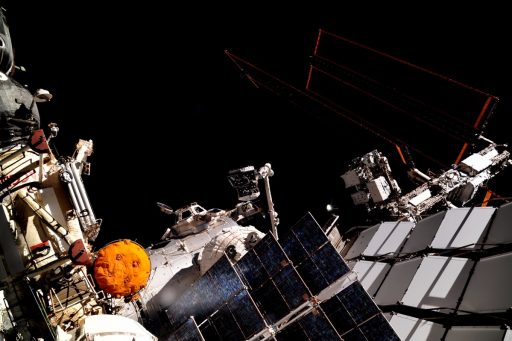
Formally known as EVA-41, Thursday’s spacewalk was primarily dedicated to outfit PMA-3 in its new location and put in place protective covers on the Node 3 module where PMA-3 resided for the last seven years. Additionally, the crew was tasked with replacing a second external computer box with an upgraded unit and teams hoped to find some time at the end of the EVA to tackle some get-ahead tasks from the Station’s to-do list.
Preparations for the EVA began bright and early on Thursday with Thomas Pesquet and Russian crew member Oleg Novitsky assisting the two spacewalkers into their Extravehicular Mobility Units for a 100-minute pre-breathe protocol. A repeating pattern with this particular crew is a tendency to jump ahead on the timeline and Thursday was no different as Kimbrough and Whitson were moved into the crew lock portion of the Quest airlock half an hour early.
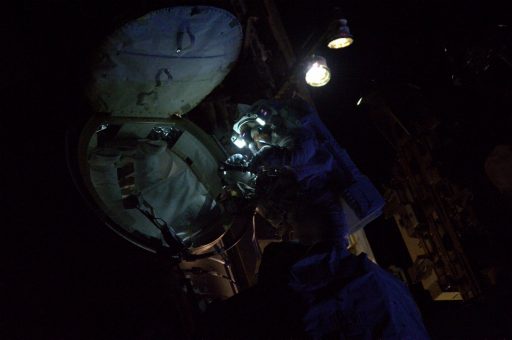
U.S. EVA-41 officially began at 11:29 UTC when the Airlock had been fully depressurized and the crew switched their suits over to battery power to head out of Quest. The two spacewalkers went through the usual checks of their suits and tethers after emerging from the airlock before both parted ways – Kimbrough was headed up to the S0 truss segment while Whitson translated forward across the lab to reach the newly installed PMA-3.
Of the Station’s three Pressurized Mating Adapters, PMA-3 was the odd one out – arriving on Station in 2000 as the last of the PMAs and then only supporting a pair of Space Shuttle dockings before being relocated several times over the next decade as ISS expanded and PMA-3 was found to be in the way of new module additions. Since 2010, PMA-3 resided on Node 3 Port and acted as extra closet space for rarely used hardware items. With the desire to establish a pair of docking ports for Commercial Crew, PMA-3 looked at a second career hosting Dragon and Starliner vehicles.
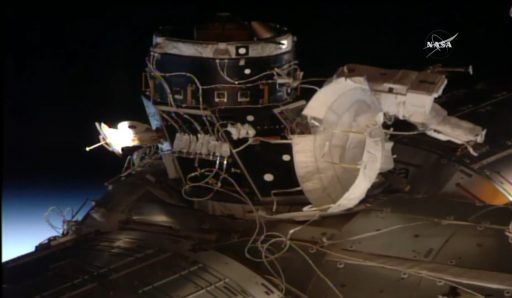
An uneventful relocation on Sunday set the stage for PMA-3 outfitting in its new location, specifically hooking the module up to power lines, putting in place protective covers at its base and removing a large hood from the end of the 1,200-Kilogram module. Each of the PMAs is around two meters long and on one end hosts a Common Berthing Mechanism (CBM) found on all U.S. Segment modules while the other end hosts an APAS docking system compatible with the Space Shuttle. For Commercial Crew, the APAS ends are converted to the International Docking Standard by installing International Docking Adapters with PMA-2 already outfitted with its IDA and PMA-3 to follow suit at the end of the year.
Arriving at PMA-3, Whitson had some difficulty releasing the caps on the A2 Patch Panel due to direct sunlight heating up the hardware but managed to shade the connectors with her space suit and get them released. She then retrieved a pair of cables pre-positioned in 2015 and installed them on PMA-3 to deliver heater power and heater feedback telemetry to enable PMA-3 to be repressurized for internal outfitting work.
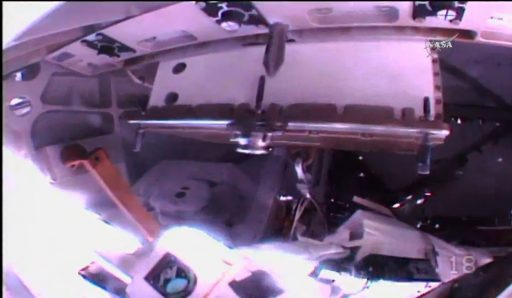
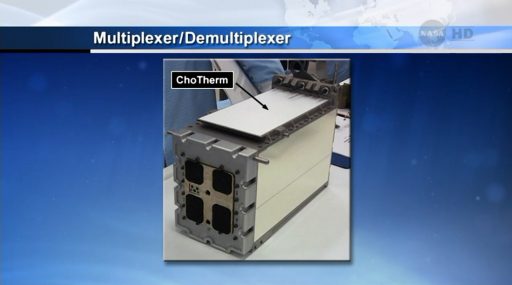
Whitson then climbed to the top of PMA-3 and released a series of straps to free up a cover that protected the APAS end of the PMA since the end of the Space Shuttle program. Folding the cover, Whitson encountered quite some difficulty as the multi-layer cover had gotten quite stiff over the years.
For Shane Kimbrough, the EVA started just like his previous spacewalk, setting up shop at S0 for the replacement of the second of two External Control Zone Multiplexers/Demultiplexers with a new, upgraded unit. After the EXT-2 MDM was changed out on EVA-40, the focus on Thursday was on the EXT-1 unit mounted to the zenith side of the central truss segment.
ISS has close to 50 MDMs, found inside and outside the complex to route commands to all systems of ISS and return telemetry and science data for downlink to the ground, essentially serving as the brains and nervous system of the Station, interconnecting all systems. The MDMs come in different sizes and basically consist of a stack of avionics cards including data processing cards, memory units and a series of input/output cards to connect to various systems and payloads.
The Station’s MDMs operate on three levels – three enhanced MDMs are used as the main controllers of all of the Station’s functions, a dozen local-level MDMs are responsible for routing commands and data from the user-level MDMs that each have specialized tasks and interface with the firmware controllers, sensors and effectors of the Station’s various systems.
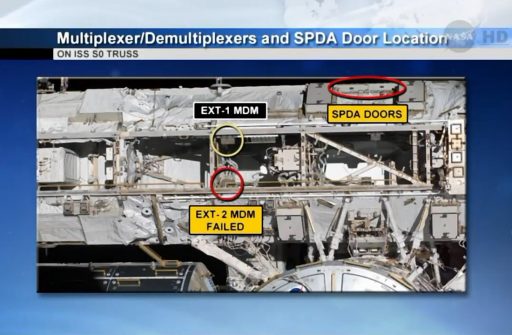
Over recent years, some of the internal MDMs were switched over to the new EPIC standard to enhance the Station’s computing power, and the replacement of the EXT MDMs has become a necessity because Ethernet capability is required by the new visiting vehicle communications system known as C2V2.
At S0 Kimbrough found the EXT-1 replacement much harder than the previous swap out due to issues with the three structural bolts that would not release properly. Several attempts were needed to fully release the old computer box and the new one was unable to stay soft-docked and had to be held by Kimbrough while tightening the central structural bolt with the Pistol Grip Tool. After driving two secondary bolts, Kimbrough made quick work to connect the Ethernet cable to fully integrate the new MDM and external communications system. He then joined Whitson at PMA-3 to lend a hand with the balky PMA-3 cover to fold it into its cover bag.
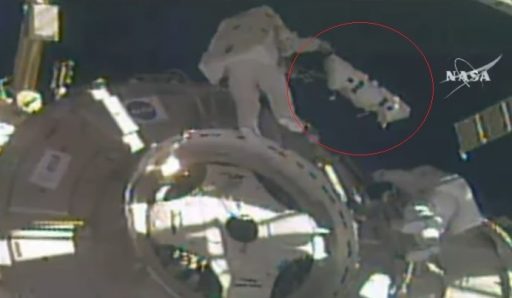
The duo then returned to the airlock, dropped off no-longer-needed equipment and picked up a bundle of axial shields headed to the Node 3 module for installation in PMA-3’s former location. Axial berthing ports on ISS lack CBM petals that can be opened and closed and therefore need covers to be installed by spacewalkers if a port is foreseen to remain unoccupied for an extended period of time.
Setting up shop at Node 3, the spacewalkers ran into a snag with one of the four axial shields that somehow became untethered and floated away from Shane Kimbrough, passing the radiators and pulling out in front of the Space Station. The rogue shield bundle did not pose a collision threat to ISS as determined by trajectory specialists, but its loss meant that one quad of the Node 3 CBM would remain exposed to the elements.
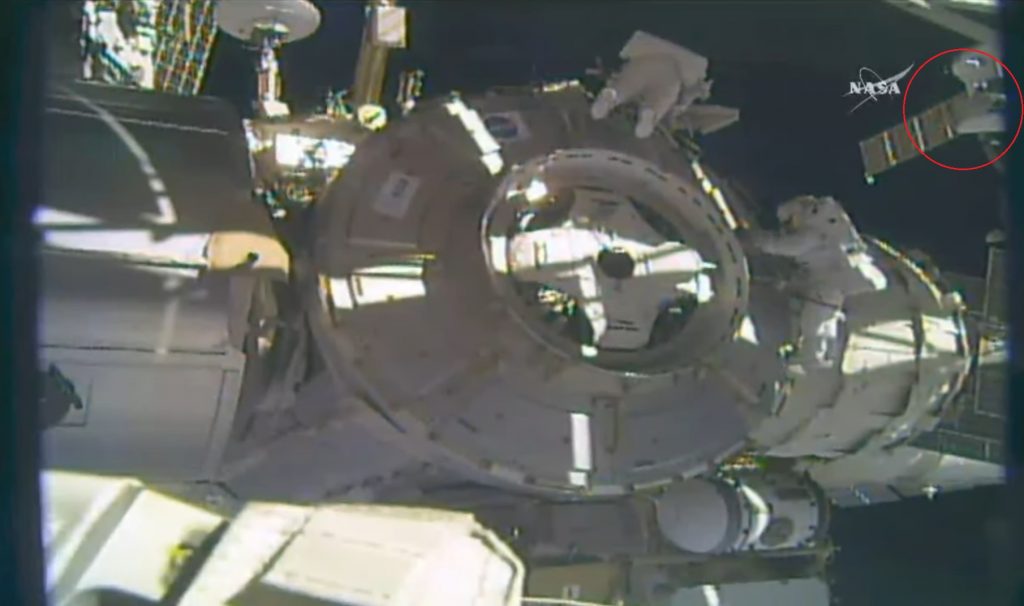
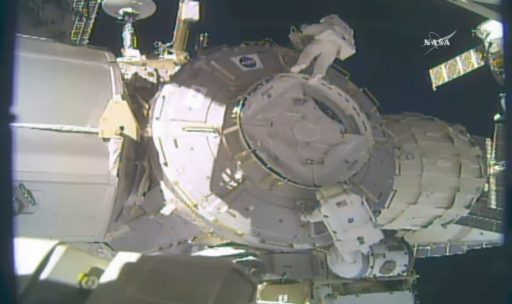
Despite the setback of losing a piece of hardware, the spacewalkers continued in methodical fashion while efforts at Mission Control became slightly more frantic as controllers began thinking on their feet to come up with a provisional plan to fully cover the berthing port. Engineers convened in a back room at Mission Control and worked with a replica of the PMA-3 cover to see whether it could be turned into a shield for Node 3.
Meanwhile, in orbit, Kimbrough and Whitson proceeded with the installation of the remaining axial shields via pairs of fasteners, Velcro straps and grounding wires. They also closed up the Centerline Berthing Camera System flap to protect the porthole window in the CBM hatch that comes into play whenever a module is berthed to the CBM.
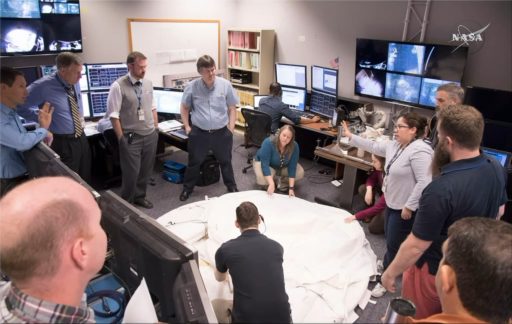
By the time the crew completed the axial shield installation, teams on the ground had come up with a workaround to get the exposed quad protected by using the PMA-3 cover that had been removed earlier in the EVA. Teams modeled possible attachment points of the cover on the Node 3 endcone and concluded it would be possible to secure the cover in place to provide adequate thermal and MMOD protection to the CBM.
With a partially finished plan, the crew got to work, retrieved the PMA cover from the airlock and folded it out over the CBM with the ground guiding them on the positioning of the cover relative to the module to allow all tethers to reach handrails or tether loops on the adjacent axial shields. It was a fairly lengthy and iterative process for the two spacewalkers, but the result ended up being a fully protected Port CBM on the Node 3 module, preserving it for future use by the NanoRacks Commercial Airlock headed to ISS toward the end of the current decade.
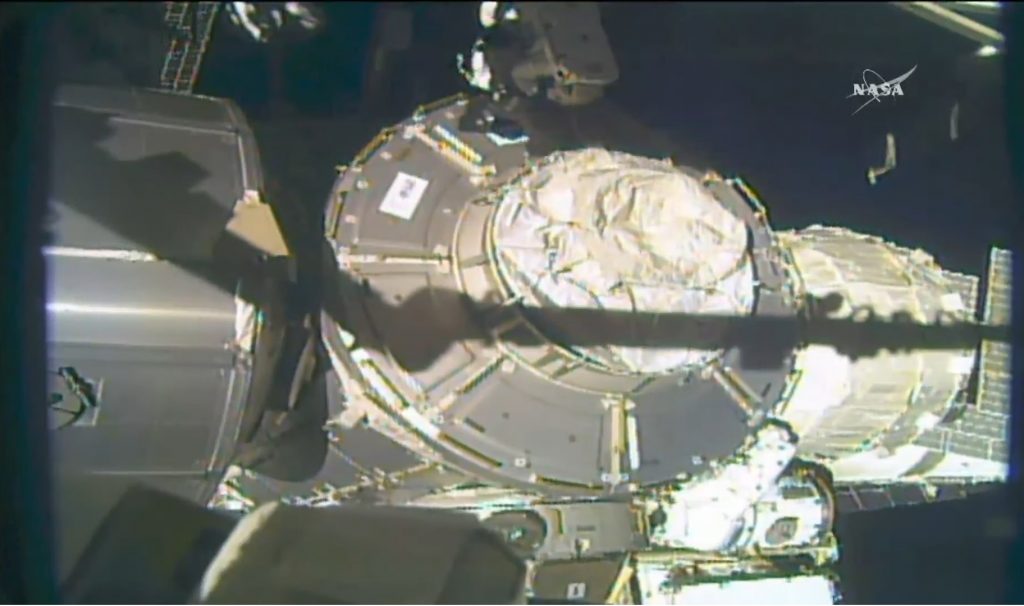
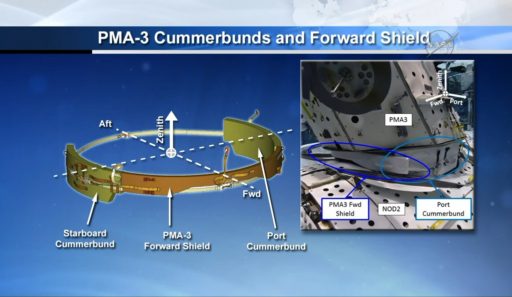
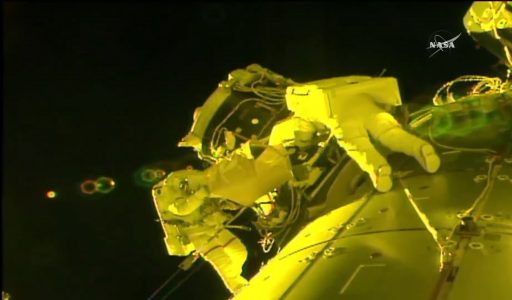
Having taken advantage of some timeline margin to deal with the makeshift cover installation, the crew was five hours into the EVA when getting started with their final scheduled task of the day that was placing a series of protective elements in place at the base of PMA-3.
When installed on an axial port of ISS, the CBM side of the PMA is shielded by the surrounding module structure but when taking up residence on the top- or underside of a module, the ISS structure falls away from the PMA and its base sits fully exposed to incoming debris, making it necessary to put in place additional shielding.
Designed to serve as protective elements for PMA-3 were two Cummerbund-type covers for either side of the PMA and a forward shield covering the broader gap in the forward section of the PMA. These covers made less trouble than those for Node 3, in part due to the availability of plenty of handrails for the crew members to keep themselves anchored while placing the covers.
After the covers were secured via tethers and cinches, the crew moved on to a single get-ahead task, translating around Harmony to inspect the Earth-facing Common Berthing Mechanism where a robotic survey had shown a build-up of FOD (Foreign Object Debris) on the sealing surface of the CBM. The spacewalkers collected imagery of the area and attempted to remove the contaminants with a scraper, only with some success. Once Mission Control was happy with the inspection, the spacewalkers were cleared to call it a day and move back to the airlock to close out the EVA in orderly fashion.
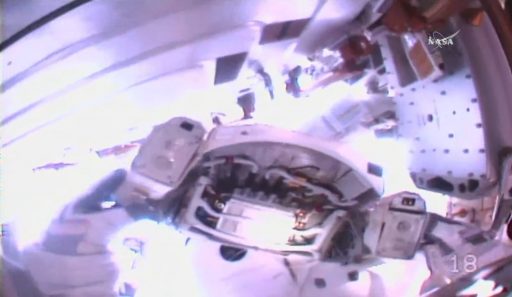
The crew’s return to the airlock again required some quick thinking when Whitson’s Helmet Camera Group containing the helmet camera and lights came loose. Shane Kimbrough came to the rescue and secured the unit before it too would have floated away into space.
Back at the airlock, the spacewalkers enjoyed one more orbital sunset and accounted for all tools and bags before climbing back inside to hook their suits up to ISS power and cooling prior to the closure of the external hatch. Repressurization started at 18:33 UTC and marked the formal end of the EVA after an elapsed time of seven hours and four minutes, running slightly long due to additional time spent with the PMA-3-cover-turned-Node-3-shield.
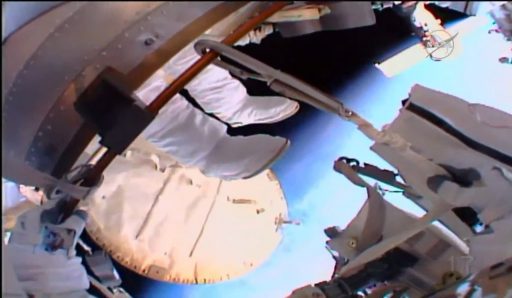
Now with six EVAs under his belt, Shane Kimbrough accumulated a career EVA time of 39 hours even while new record-holder Peggy Whitson has performed eight EVAs for a total of 53 hours and 22 minutes. She will move up to the third place in the all-time list after her next EVA currently expected no earlier than late April.
The cumulative spacewalk time for Expedition 50’s four EVAs to date is 26 hours and 8 minutes.
U.S. EVA-42 by Peggy Whitson and Thomas Pesquet was originally planned for April 6 but is dependent on the Cygnus OA-7 cargo mission that will lift a pair of hardware items needed for that spacewalk. The SS John Glenn is currently looking at a launch around mid-April to fix a hydraulic issue on the mission’s Atlas V booster. To conduct a non-contingency stage EVA, NASA prefers to have three USOS crew members on ISS and will therefore defer EVA-42 until after April’s Soyuz crew rotation.

